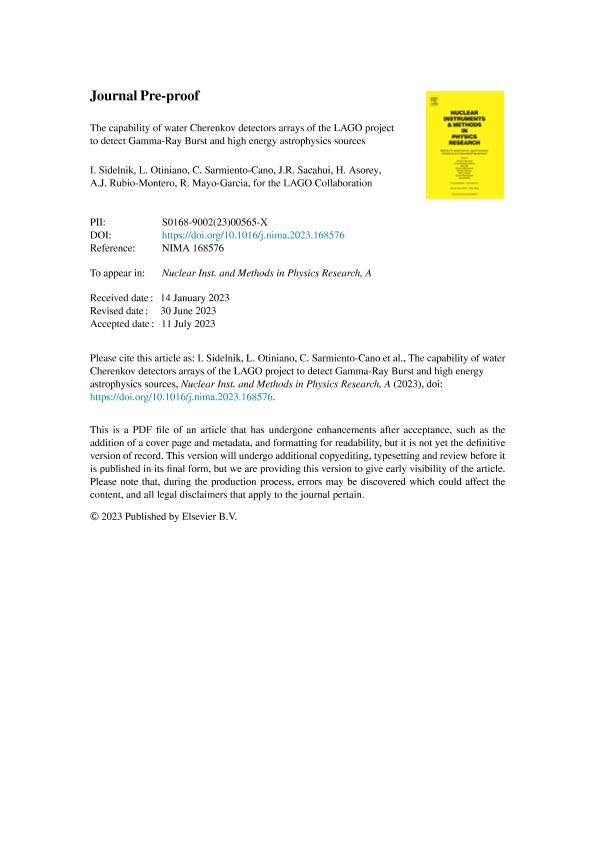Mostrar el registro sencillo del ítem
dc.contributor.author
Sidelnik, Iván Pedro

dc.contributor.author
Otiniano, L.
dc.contributor.author
Sarmiento Cano, C.
dc.contributor.author
Sacahui, J. R.
dc.contributor.author
Asorey, Hernán Gonzalo

dc.contributor.author
Rubio Montero, A. .J.
dc.contributor.author
Mayo Garcia, R.
dc.date.available
2024-01-30T12:51:58Z
dc.date.issued
2023-07
dc.identifier.citation
Sidelnik, Iván Pedro; Otiniano, L.; Sarmiento Cano, C.; Sacahui, J. R.; Asorey, Hernán Gonzalo; et al.; The capability of water Cherenkov detectors arrays of the LAGO project to detect Gamma-Ray Burst and high energy astrophysics sources; Elsevier Science; Nuclear Instruments and Methods in Physics Research A: Accelerators, Spectrometers, Detectors and Associated Equipament; 1056; 7-2023; 1-5
dc.identifier.issn
0168-9002
dc.identifier.uri
http://hdl.handle.net/11336/225198
dc.description.abstract
Gamma-Ray Bursts (GRBs) are one of the brightest transient events detected, with energies in their prompt phase ranging from keV to GeV. Theoretical models predict emissions at higher energies in the early times of the afterglow emission, and recently GRB190114C was the first GRB detected at TeV energies by the MAGIC experiment. The Latin American Giant Observatory (LAGO) operates a network of water Cherenkov detectors (WCD) at different sites in Latin America. Spanning over different altitudes and geomagnetic rigidity cutoffs, the geographic distribution of the LAGO sites, combined with the new electronics for control, atmospheric sensing, and data acquisition, allows the realization of diverse astrophysics studies at a regional scale. LAGO WCDs located at high altitudes possess good sensitivity to electromagnetic secondary radiation, which is the main expected signature of this kind of high-energy event on the ground. Due to the characteristics of the WCD and the wide field of view, LAGO possesses a large aperture high-duty cycle. In this work, we present the results of the sensitivity of LAGO small arrays of WCDs for the detection of events like GRB190114C. Also, we extend the study to other TeV galactic emitters, such as pulsar wind nebulas, TeV-halos, and some additional sources with unidentified categorizations. These are interesting sources to study taking advantage of the long-term monitoring capabilities of LAGO. We use a dedicated simulation process: ARTI, a toolkit developed by LAGO for high-energy air showers, MEIGA, a framework to simulate the response of the detectors, and oneDataSim, the new high-performance computing and cloud-based implementation of our simulation framework.
dc.format
application/pdf
dc.language.iso
eng
dc.publisher
Elsevier Science

dc.rights
info:eu-repo/semantics/openAccess
dc.rights.uri
https://creativecommons.org/licenses/by-nc-sa/2.5/ar/
dc.subject
GAMMA RAY BURST
dc.subject
LAGO COLLABORATION
dc.subject
WATER CHERENKOV DETECTOR
dc.subject.classification
Física de Partículas y Campos

dc.subject.classification
Ciencias Físicas

dc.subject.classification
CIENCIAS NATURALES Y EXACTAS

dc.subject.classification
Astronomía

dc.subject.classification
Ciencias Físicas

dc.subject.classification
CIENCIAS NATURALES Y EXACTAS

dc.title
The capability of water Cherenkov detectors arrays of the LAGO project to detect Gamma-Ray Burst and high energy astrophysics sources
dc.type
info:eu-repo/semantics/article
dc.type
info:ar-repo/semantics/artículo
dc.type
info:eu-repo/semantics/publishedVersion
dc.date.updated
2024-01-29T15:48:03Z
dc.journal.volume
1056
dc.journal.pagination
1-5
dc.journal.pais
Países Bajos

dc.journal.ciudad
Amsterdam
dc.description.fil
Fil: Sidelnik, Iván Pedro. Comisión Nacional de Energía Atómica. Gerencia del Área de Energía Nuclear. Gerencia de Ingeniería Nuclear (CAB). División Neutrones y Reactores; Argentina. Consejo Nacional de Investigaciones Científicas y Técnicas. Centro Científico Tecnológico Conicet - Patagonia Norte; Argentina
dc.description.fil
Fil: Otiniano, L.. No especifíca;
dc.description.fil
Fil: Sarmiento Cano, C.. Universidad Industrial Santander; Colombia
dc.description.fil
Fil: Sacahui, J. R.. Universidad de San Carlos de Guatemala (univ. de San C. de Guatemala);
dc.description.fil
Fil: Asorey, Hernán Gonzalo. Comisión Nacional de Energía Atómica. Centro Atómico Bariloche; Argentina. Consejo Nacional de Investigaciones Científicas y Técnicas. Centro Científico Tecnológico Conicet - Patagonia Norte; Argentina
dc.description.fil
Fil: Rubio Montero, A. .J.. Centro de Investigaciones Energeticas Medioambientales y Tecnologicas (ciemat);
dc.description.fil
Fil: Mayo Garcia, R.. Centro de Investigaciones Energeticas Medioambientales y Tecnologicas (ciemat);
dc.journal.title
Nuclear Instruments and Methods in Physics Research A: Accelerators, Spectrometers, Detectors and Associated Equipament

dc.relation.alternativeid
info:eu-repo/semantics/altIdentifier/url/https://linkinghub.elsevier.com/retrieve/pii/S016890022300565X
dc.relation.alternativeid
info:eu-repo/semantics/altIdentifier/doi/http://dx.doi.org/10.1016/j.nima.2023.168576
Archivos asociados
